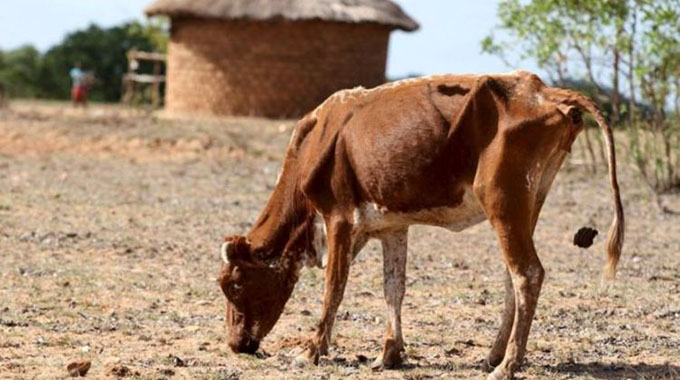Zim’s livestock extension system needs more support

Sifelani Tsiko Agric, Environment & Innovations Editor
Elijah GUNDA, a farmer at Chakabva Village in the drought-prone Hurungwe District in the northern part of the country is distressed by the condition of his cattle.
In October, lions which had strayed from Charara Safari Area, killed two of his assets and draught power — two cattle. Apart from this, his failure to secure veterinary services to treat his only surviving cow which has a calf has brought more misery to him.
His cow and the calf are frail and Gunda is unsure whether or not they will survive.
“We have no veterinary services here any more,” he said.
“We buy vaccines from Magunje Growth Point and it’s very expensive. We can’t afford the drugs.”
As a result, a number of smallholder farmers have lost their livestock due to the problems facing the Department of Livestock and Veterinary Ser-vices which is perennially underfunded.
Most farmers in Hurungwe say the animal health extension services are almost non-existent.
All this is largely due to a myriad of problems facing veterinary extension support delivery systems in communal areas.
The veterinary extension system which was once the pride of Africa is now riddled with shortages of drugs, lack of transport for extension workers and even training of smallholder farmers.
Drugs such as acaricides used to control ticks are in short supply and unavailable in the Hurungwe communal area.
Gunda has to travel more than 40km to Magunje to buy the drugs.
The situation gets trickier when some hardware retail shops demand to be paid in foreign currency.
Government is no longer able to provide clinical veterinary services to all parts of the country due to budgetary constraints.
Extension staff in Hurungwe and most other parts of the country are either incapacitated due to lack of equipment, transport and drugs or are too few to be accessible when needed.
As a result, the causes of deaths in domestic animals is no longer easy to establish due to the collapse of veterinary services in Hurungwe and most other parts of the country.
Livestock services provided by Government are mainly run by vets and focus on animal health issues that covers curative treatment of individual animals, preventive health and health screening of animal products.
“Tsetse flies are a major problem in our area,” said Wiseman Mumba, a councillor of Ward 26 of the Nyaodza area of Hurungwe district.
“We have no chemicals to fight tsetse flies. We are forced to buy drugs on our own to treat affected cattle. The veterinary service extension workers are no longer able to assist us due to lack of transport, equipment and drugs.
“Something must be done soon to avert a disaster in our livestock here in Hurungwe.”
The crisis facing the Department of Livestock and Veterinary Services has left the country exposed to transboundary animal diseases.
This is now a major constraint to the improvement of the livestock industry in Zimbabwe. Smallholder cattle farming systems now have high ani-mal mortality through diseases.
Drought, shortage of feed, shortage of water and livestock diseases are now the top ranked constraints for livestock production in most parts of the country.
The United Nations through Food and Agriculture Organisation (FAO) with support of the Japanese Embassy in Zimbabwe is working with Gov-ernment to implement a US$300 000 emergency response project focusing on human wildlife conflicts in Hurungwe district in Mashonaland West province.
The programme is supporting the Department of Livestock and Veterinary Services to offer training to animal health extension workers to enhance knowledge of transboundary diseases (TADs), improve veterinary surveillance systems and disease reporting systems amongst veterinary services per-sonnel in Hurungwe district.
Extension workers are expected to share their knowledge with local communities.
“The livestock extension system is facing numerous challenges — ranging from lack of vehicles, motorbikes, bicycles, poor cold chain for vaccine storage, poor training of staff, lack of accommodation for staff and more importantly lack of vaccines and laboratory equipment,” said Dr Kurai Ka-pondo, a veterinary expert at a training workshop for extension workers.
“Our laboratory equipment is obsolete and we have a huge backlog of samples requiring testing. We need more support to revitalise our services.
Livestock production is an important component of agricultural activities in Zimbabwe. Smallholder farmers keep livestock for various uses includ-ing draught power, milk, meat, eggs and various cultural uses. They complement cropping activities through the provision of manure for soil fertility maintenance, draught power for cultivation, transport, cash and food.
In addition, livestock play an important role in these farming systems, as they offer opportunities for risk coping, farm diversification and liveli-hood benefits.
The FAO programme is aiming to improve livestock policies, animal health systems and strengthening the whole livestock value chain.
Ticks and tickborne diseases (TBDs) are responsible for major cattle losses and account for up to 65 percent of cattle mortality in Zimbabwe.
Zimbabwe is targeting to restore food self-sufficiency as part of its national food security strategy. The livestock industry is striving to rebuild the animal protein base through herd restocking and strengthening animal health systems and disease surveillance.
The country has been self-sufficient in meat and eggs since 2012 and is set to achieve self-sufficiency in dairy production by 2022 on the back of public policy support and international donor support.
Zimbabwe’s famed livestock industry has been struggling since the 2000s following outbreaks of foot-and-mouth disease, but is now rebounding.
Apart from the foot-and-mouth disease, the livestock sector had been hit by crippling economic sanctions imposed on the country by Western na-tions, which contributed to hyperinflation and huge animal health management costs.
Weak management of livestock farms also compounded the problems.
In the past, Zimbabwe’s beef cattle herd topped 1,4 million and raked in more than US$50 million yearly from exports to the lucrative European market, particularly the UK, Germany and the Netherlands.
And, despite the problems, the livestock sector is slowly stampeding and crawling back to life bringing hope to the country’s economic revival efforts.









Comments